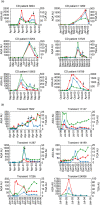Antibody responses to deamidated gliadin peptide show high specificity and parallel antibodies to tissue transglutaminase in developing coeliac disease
- PMID: 17803713
- PMCID: PMC2219356
- DOI: 10.1111/j.1365-2249.2007.03487.x
Antibody responses to deamidated gliadin peptide show high specificity and parallel antibodies to tissue transglutaminase in developing coeliac disease
Abstract
Coeliac disease (CD) is an enteropathy induced in genetically susceptible individuals by gluten components, gliadin, hordein and secalin, polypeptides present in cereals such as wheat, barley and rye, respectively. Although the disease starts as intolerance to gliadins, antibodies to tissue transglutaminase (tTG) in the gut epithelium are characteristic of the disease. Whereas serum autoantibodies against tTG (tTGA) are highly specific for CD, antibodies to gliadin are less informative as they can also be detected in other enteropathies, and even in healthy individuals. However, it was shown recently that antibodies to certain gliadin peptides occur with high specificity in CD patient sera. We developed a solid phase lanthanide-based immunofluorometric assay for simultaneous detection of serum IgA and IgG antibodies to a synthetic peptide derived from gamma gliadin of wheat comprising amino acids 86-103. Three glutamine residues of this native 18-mer peptide were replaced by glutamic acids and the peptide was biotinylated. Sera from 87 individuals who had undergone duodenal biopsy and were diagnosed with CD and from 81 healthy individuals were analysed for the presence of both IgA and IgG anti-gliadin peptide antibodies. The performance of the peptide AGA assay was excellent, showing a specificity and sensitivity of 90% and 92% for IgA, and 98% and 75% for IgG, respectively. The corresponding values for conventional anti-gliadin antibody (AGA) enzyme-linked immunosorbent assay (ELISA) tests were 72% specificity and 87% sensitivity for IgA, and 64% specificity and 78% sensitivity for IgG. In a prospective study, almost all the tTGA-positive sera drawn from children who later developed CD were also positive for gliadin peptide antibodies.
Figures



Similar articles
-
Tissue transglutaminase antibodies in celiac disease, comparison of an enzyme linked immunosorbent assay and a dot blot assay.Pathol Biol (Paris). 2005 May;53(4):204-9. doi: 10.1016/j.patbio.2004.07.022. Pathol Biol (Paris). 2005. PMID: 15850953
-
[Relevance of anti-tissue transglutaminase antibodies in coeliac disease diagnosis].Ann Biol Clin (Paris). 2003 May-Jun;61(3):337-43. Ann Biol Clin (Paris). 2003. PMID: 12805013 French.
-
Accuracy of diagnostic antibody tests for coeliac disease in children: summary of an evidence report.J Pediatr Gastroenterol Nutr. 2012 Feb;54(2):229-41. doi: 10.1097/MPG.0b013e318216f2e5. J Pediatr Gastroenterol Nutr. 2012. PMID: 22266486 Review.
-
Diagnostic value of anti-deamidated gliadin peptide IgG antibodies for celiac disease in children and IgA-deficient patients.J Pediatr Gastroenterol Nutr. 2012 Jul;55(1):50-5. doi: 10.1097/MPG.0b013e31824703c7. J Pediatr Gastroenterol Nutr. 2012. PMID: 22197936
-
Prospective screening for coeliac disease in patients with Graves' hyperthyroidism using anti-gliadin and tissue transglutaminase antibodies.Clin Endocrinol (Oxf). 2005 Mar;62(3):303-6. doi: 10.1111/j.1365-2265.2005.02214.x. Clin Endocrinol (Oxf). 2005. PMID: 15730411 Review.
Cited by
-
Novel Therapies for Celiac Disease: A Clinical Review Article.Cureus. 2023 May 14;15(5):e39004. doi: 10.7759/cureus.39004. eCollection 2023 May. Cureus. 2023. PMID: 37323330 Free PMC article. Review.
-
The role of serology in the diagnosis of coeliac disease.Gastroenterol Hepatol Bed Bench. 2023;16(2):118-128. doi: 10.22037/ghfbb.v16i2.2713. Gastroenterol Hepatol Bed Bench. 2023. PMID: 37554756 Free PMC article. Review.
-
Immunoreactivity of antibodies against transglutaminase-deamidated gliadins in adult celiac disease.Dig Dis Sci. 2008 Oct;53(10):2697-701. doi: 10.1007/s10620-007-0191-9. Epub 2008 Feb 28. Dig Dis Sci. 2008. PMID: 18306039
-
Combination testing for antibodies in the diagnosis of coeliac disease: comparison of multiplex immunoassay and ELISA methods.Aliment Pharmacol Ther. 2008 Sep 15;28(6):805-13. doi: 10.1111/j.1365-2036.2008.03797.x. Aliment Pharmacol Ther. 2008. PMID: 19145736 Free PMC article.
-
Application of Deamidated Gliadin Antibodies in the Follow-Up of Treated Celiac Disease.PLoS One. 2015 Aug 31;10(8):e0136745. doi: 10.1371/journal.pone.0136745. eCollection 2015. PLoS One. 2015. PMID: 26322980 Free PMC article.
References
-
- Koning F, Schuppan D, Cerf-Bensussan N, Sollid LM. Pathomechanisms in celiac disease. Best Pract Res Clin Gastroenterol. 2005;19:373–87. - PubMed
-
- Sollid LM. Molecular basis of celiac disease. Annu Rev Immunol. 2000;18:53–81. - PubMed
-
- Aleanzi M, Demonte AM, Esper C, Garcilazo S, Waggener M. Celiac disease: antibody recognition against native and selectively deamidated gliadin peptides. Clin Chem. 2001;47:2023–8. - PubMed
-
- Sjostrom H, Lundin KE, Molberg O, et al. Identification of a gliadin T-cell epitope in coeliac disease: general importance of gliadin deamidation for intestinal T-cell recognition. Scand J Immunol. 1998;48:111–5. - PubMed
-
- Molberg O, McAdam SN, Korner R, et al. Tissue transglutaminase selectively modifies gliadin peptides that are recognized by gut-derived T cells in celiac disease. Nat Med. 1998;4:713–7. - PubMed
Publication types
MeSH terms
Substances
LinkOut - more resources
Full Text Sources
Other Literature Sources
Medical
Miscellaneous

